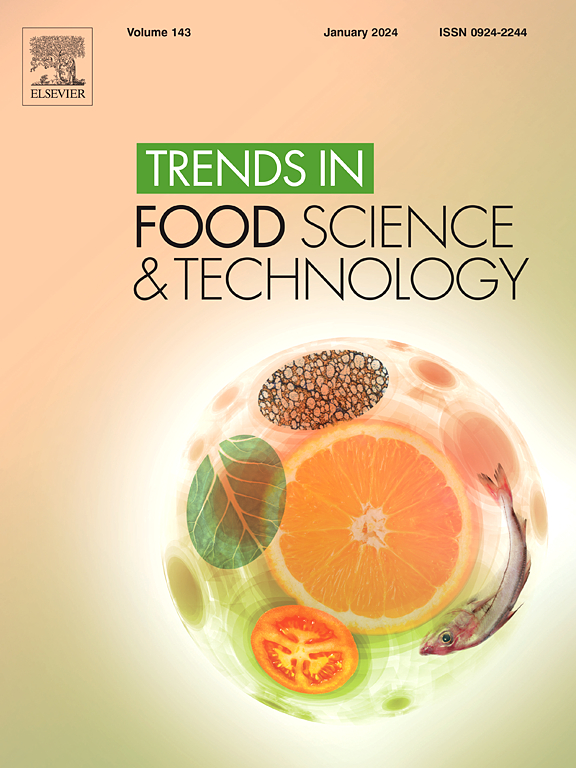AI-based low-altitude delivery fresh food supply Chain: Research progress and trends
IF 15.1
1区 农林科学
Q1 FOOD SCIENCE & TECHNOLOGY
引用次数: 0
Abstract
Background
Fresh food is an indispensable part of daily life and is consumed by people in relatively large quantities. However, it is a perishable food, which can easily lead to a decline in freshness and a decrease in nutritional value during the supply chain process, and therefore the efficient operation of its supply chain is crucial for ensuring product quality, reducing wastage, lowering costs, and improving customer satisfaction.
Scope and approach
Here, we examine how integrating low-altitude delivery technologies—such as unmanned aerial vehicles (UAVs)—with artificial intelligence (AI) can transform freshness preservation and operational sustainability. The combination of low-altitude delivery technology (e.g., UAVs) and AI provides a new paradigm for the efficiency and intelligence of fresh food supply chain. This paper analyzes the important role of AI in demand forecasting and inventory management, path optimization and dynamic scheduling, quality monitoring and management, Autonomous obstacle avoidance and safety control, and highlighting the innovation potential of UAV-enabled supply chain delivery. The challenges and future development direction of AI low-altitude delivery in fresh food supply chain are discussed.
Key findings and conclusions
This review shows that AI-driven low-altitude delivery can improve the efficiency and sustainability of the fresh food supply chain and help to protect the quality characteristics of fresh food. However, technological and public acceptability hurdles remain, including the need for low-noise UAVs, continued advancements in drone capabilities, the establishment of robust regulatory standards, and the protection of data security. Despite these challenges, the integration of AI-driven low-altitude delivery technologies into fresh food supply chains represents an emerging trend in delivery innovation. Integrating UAVs with unmanned electric refrigerated vehicles and delivery robots is expected to form an efficient and environmentally sustainable delivery model. Adopting shared-use UAV fleets for low-altitude fresh food delivery can reduce operational costs while supporting multifunctional applications in drone delivery. By adopting these innovations, AI-enabled low-altitude delivery systems could transform fresh food supply chains, minimizing waste, and aligning with global sustainability goals.
基于人工智能的低空配送生鲜食品供应链研究进展与趋势
背景新鲜食品是人们日常生活中不可缺少的一部分,消费量也相对较大。然而,它是一种易腐食品,在供应链过程中很容易导致新鲜度下降和营养价值下降,因此其供应链的高效运行对于确保产品质量,减少浪费,降低成本,提高客户满意度至关重要。在这里,我们将研究如何将低空运输技术(如无人驾驶飞行器(uav))与人工智能(AI)相结合,以改变新鲜度保存和运营可持续性。低空配送技术(如无人机)与人工智能的结合,为生鲜食品供应链的效率和智能化提供了新的范例。本文分析了人工智能在需求预测与库存管理、路径优化与动态调度、质量监控与管理、自主避障与安全控制等方面的重要作用,并重点介绍了无人机助力供应链配送的创新潜力。讨论了人工智能低空配送在生鲜食品供应链中的挑战和未来发展方向。本综述表明,人工智能驱动的低空配送可以提高生鲜食品供应链的效率和可持续性,并有助于保护生鲜食品的质量特征。然而,技术和公众可接受性障碍仍然存在,包括对低噪音无人机的需求,无人机能力的持续进步,强有力的监管标准的建立,以及数据安全的保护。尽管存在这些挑战,但将人工智能驱动的低空配送技术整合到生鲜食品供应链中代表了配送创新的新兴趋势。将无人机与无人驾驶电动冷藏车和送货机器人相结合,有望形成一种高效且环境可持续的送货模式。采用共享使用的无人机机队进行低空生鲜食品配送,可以降低运营成本,同时支持无人机配送的多功能应用。通过采用这些创新,人工智能低空配送系统可以改变生鲜食品供应链,最大限度地减少浪费,并与全球可持续发展目标保持一致。
本文章由计算机程序翻译,如有差异,请以英文原文为准。
求助全文
约1分钟内获得全文
求助全文
来源期刊

Trends in Food Science & Technology
工程技术-食品科技
CiteScore
32.50
自引率
2.60%
发文量
322
审稿时长
37 days
期刊介绍:
Trends in Food Science & Technology is a prestigious international journal that specializes in peer-reviewed articles covering the latest advancements in technology, food science, and human nutrition. It serves as a bridge between specialized primary journals and general trade magazines, providing readable and scientifically rigorous reviews and commentaries on current research developments and their potential applications in the food industry.
Unlike traditional journals, Trends in Food Science & Technology does not publish original research papers. Instead, it focuses on critical and comprehensive reviews to offer valuable insights for professionals in the field. By bringing together cutting-edge research and industry applications, this journal plays a vital role in disseminating knowledge and facilitating advancements in the food science and technology sector.
 求助内容:
求助内容: 应助结果提醒方式:
应助结果提醒方式:


